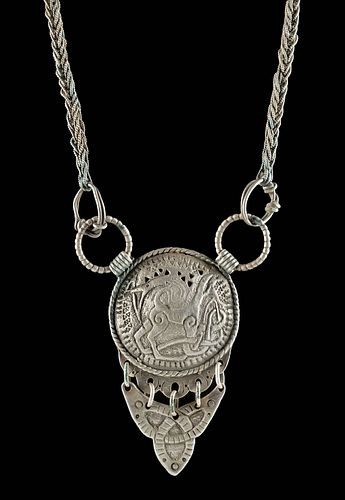Rare Viking Silver Jellinge Chain w/ Diffuser Pendant
About Seller
686 S Taylor Ave, Ste 106
Louisville, CO 80027
United States
Selling antiquities, ancient and ethnographic art online since 1993, Artemis Gallery specializes in Classical Antiquities (Egyptian, Greek, Roman, Near Eastern), Asian, Pre-Columbian, African / Tribal / Oceanographic art. Our extensive inventory includes pottery, stone, metal, wood, glass and textil...Read more
Two ways to bid:
- Leave a max absentee bid and the platform will bid on your behalf up to your maximum bid during the live auction.
- Bid live during the auction and your bids will be submitted real-time to the auctioneer.
Bid Increments
| Price | Bid Increment |
|---|---|
| $0 | $25 |
| $300 | $50 |
| $1,000 | $100 |
| $2,000 | $250 |
| $5,000 | $500 |
| $10,000 | $1,000 |
| $20,000 | $2,500 |
| $50,000 | $5,000 |
| $100,000 | $10,000 |
| $200,000 | $20,000 |
About Auction
Nov 10, 2022
Museum-worthy examples of classical antiquities (Egyptian, Greek, Roman, Near Eastern), Viking, Far East / Asian, Pre-Columbian, African / Tribal, Oceanic, Native American, Spanish Colonial, Nautical, Fossils, Ancient Jewelry, Fine / Visual Arts, so much more! Artemis Gallery info@artemisgallery.com
- Lot Description
Northern Europe, Scandinavia, Denmark, Viking or Norse culture, ca. late 9th to 10th century CE. A lengthy necklace chain comprised of several braided, twisted strands of 94% to 96% silver wire that can be worn with any outfit! Dangling from the chain's ring terminals is a rare Jellinge type pendant of convex circular form presenting an abstract zoomorphic creature known as a "gripping beast" due to its tendril-like legs. The creature is surrounded by radiating frets and delicate triangular stamps, and dangling below via 5 suspension rings is a braided triangular emblem. The verso of the pendant has a petite receptacle used for inserting oil-soaked fabric or herbs for personal incense. Size (pendant): 1.95" W x 3.45" H (5 cm x 8.8 cm); (chain): 30.5" L (77.5 cm); silver quality: 94% to 96% for chain, 99% for pendant; total weight: 118.3 grams
This is an incredible piece of wearable artwork and displayed wealth, which in the volatile Viking period often manifested in the form of jewelry made from precious metals, this necklace would have belonged to one of the most elite members of society.
The Jellinge Style (ca. 880 to 1000 CE) refers to a genre of ancient Scandinavian animal art that features stylized zoomorphic forms. Its name is derived from a small cup that was discovered in a royal burial mound at Jellinge, Denmark which was believed to be the burial place of King Gorm. This cup was decorated with S-shaped animals possessing profiled heads, ribbon-like bodies, spiral hips, and curled upper lips.
The important Viking metalworking shops correspond to their great trading ports and proto-urban centers - Birka, Helgo, Sigtuna, and Lund in Sweden, Ribe, Haithabu (Hedeby), and Fyrkat in Denmark, and Kaupang and Trondheim in Norway. Silver was the principal currency of the Viking world, which stretched from Russia to northern Canada at the height of their influence. In many places, the Vikings kept silver not as coins, but as jewelry, a wearable currency form that was not subject to the authority of a monarch or mint. One of the most common archaeological finds from the Viking period is a hoard of metal objects, often buried in the earth or deposited in bodies of water, like river beds.
Provenance: private New York, New York, USA collection; ex-private Kaliningrad (Koenigsberg) and then Latvia collection; found on the Baltic Sea coast prior to 1982
All items legal to buy/sell under U.S. Statute covering cultural patrimony Code 2600, CHAPTER 14, and are guaranteed to be as described or your money back.
A Certificate of Authenticity will accompany all winning bids.
We ship worldwide and handle all shipping in-house for your convenience.
#175641Professional cleaning to chain and pendant, with light abrasions, softening to finer motifs, light earthen deposits and oxidation in areas, and some pitting, otherwise intact and excellent. Great patina throughout.Condition
- Shipping Info
-
Artemis Gallery will no longer be able to offer in-house shipping for most international orders, as well as all oversized orders, including most paintings. These items are clearly marked in the listing as “3rd Party Shipping Required” in the listing. We have a list of recommended third party shippers to assist you in shipping to and from, and would be happy to assist you in working with them. We require a written authorization from the client to release property to any third party. You may fax a Shipping Release Form to 303-828-3235 or email your authorization to kristen@artemisgallery.com. Please note the all property must be removed from our premises within seven (7) business days following the last day of the auction.
-
- Buyer's Premium



 EUR
EUR CAD
CAD AUD
AUD GBP
GBP MXN
MXN HKD
HKD CNY
CNY MYR
MYR SEK
SEK SGD
SGD CHF
CHF THB
THB














